Please Take Note: This is a review of the final game, but it might change slightly based on the success of the Kickstarter campaign. The game is being reviewed on the components and the rules provided with the understanding that “what you see is not what you might get” when the game is published. If you like what you read and want to learn more, we encourage you to visit the Kickstarter campaign. Now that we have all that disclaimer junk out of the way, on with the review.
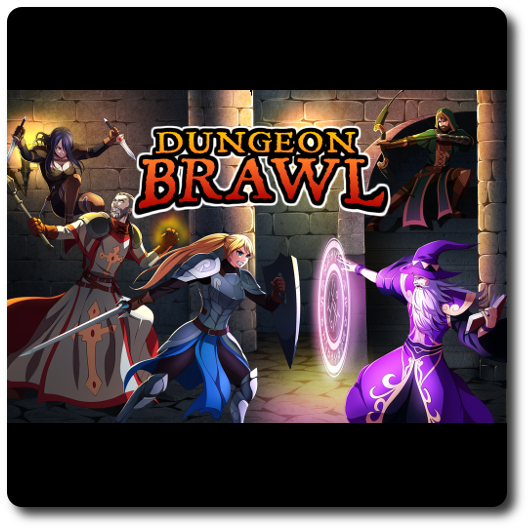
The Basics:
- For ages 10 and up (publisher suggests 12+)
- For 3 to 5 players
- Approximately 45 minutes to complete
Geek Skills:
- Active Listening & Communication
- Counting & Math
- Logical & Critical Decision Making
- Reading
- Memorization
- Strategy & Tactics
- Hand/Resource Management
Learning Curve:
- Child – Easy
- Adult – Easy
Theme & Narrative:
- There is no such thing as “sharing treasure”
Endorsements:
- Gamer Geek approved!
- Parent Geek approved!
- Child Geek approved!
Overview
You have survived the terrors of the dungeon and defeated the final boss. Before you lies a treasure pile just waiting to be plundered. But wait. Why should you share this with your so-called friends? Didn’t you deliver the final stroke that killed the dragon? Wasn’t it you who made sure the rest of the party survived? You should have the majority of the treasure! Now to convince the others…
Dungeon Brawl, designed by Ramon Raya and to be published by Tableflip Games, will reportedly be comprised of 248 cards, 1 game board, 5 Character pawns, 5 plastic stands (for the Character pawns), and one standard six-sided die. As this is a review of a prepublished game, I cannot comment on the game component quality. The artwork is fantastic, bringing to illustrative life the fantasy characters who are kicking each others butts to take all the treasure.
Prepare Your Party
To set up the game, first have each player select a class in turn order sequence. Each class has its specialties, but none have a decisive advantage over the other. Each has a unique means of survival, but they are all survivors. The classes are as follows and each player will grab cards from a pool to create a unique deck of 12 cards. Any cards not used are return to the game box.
- The Warrior
- The Rogue
- The Ranger
- The Wizard
- The Cleric
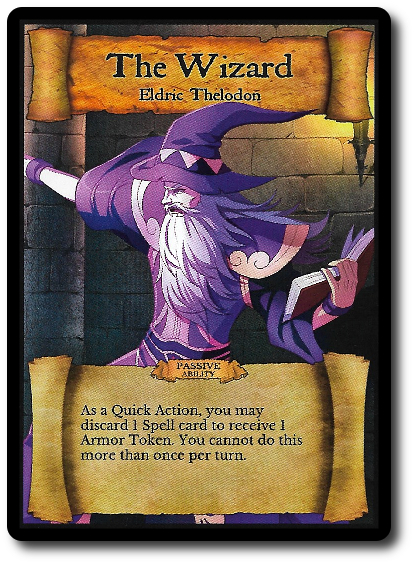
Second, the last player to select a class is now the first player to select an Artifact. Artifacts are powerful items that most certainly do give the player an advantage. After selecting the starting Artifact, return all unused Artifacts back to the game box. Players take their selected Artifact and add it to their deck.
Third, each player is given three Wound cards, which are also added to the player’s decks (which should now contain a total of 16 cards).
Fourth, separate the Trap cards by level and then shuffle each separately. One card is removed at random and returned to the game box. Then stack the Trap decks by level, with Level One on top, followed by Level Two, and the last (and bottom) being Level Three. Place this deck face-down and to one side of the game playing area. This is the Trap draw deck.
Fifth, take the Wound and Treasure cards and create a single deck. The number of cards in the deck is dependent on the number of players. For example, in a five player game, you would add 25 Wound cards and 15 Treasure cards, but only 15 Wound cards and 5 Treasure cards if playing with only three players. Shuffle these cards to create a single deck. This is the Wound draw deck for the duration of the game. Return any unused cards to the game box.
Sixth, place the game board in the middle of the playing area. In turn order sequence, have each player take their Character pawn and place it to the board. Any number of Character pawns can occupy the same square space. Players should keep in mind what their selected class is when placing. For example, the Ranger is great at ranged attacks, so should be placed as far away as possible from others. Place the Wound draw deck face-down next to the game board.
That’s it for game set up. Have each player shuffle their own decks and draw six cards to create their starting hand.
That’s My Treasure!
Dungeon Brawl is played in rounds and turns with no set number of rounds per game. A player’s turn is summarized here.
Phase one: Removal
The first thing the player does is review what cards they played on their last turn and discards any Spell, Tokens, Buffs, and other cards with temporary effects. Only those cards played during the player’s last turn are discarded to the player’s discard pile. Any card that was played out of turn (in reaction to an opponent’s played cards) remain.
At this time, the player should remind their opponents that any cards they played out of turn in reaction to what the current player played should be removed. All cards played out of turn are discarded on the player’s turn in which they were created.
Phase Two: Traps
The starting player draws and reveals a new Trap card from the top of the Trap draw deck. This phase is NOT taken by the other players (only the starting player draws the traps). The Trap card is shown to all and then resolved. Trap cards target specific squares on the game board either through a die roll, player action, or predefined conditions. Once the Trap card is resolved, it’s discarded.

Phase Three: Action
The player can now make one Move action and one Attack action in any order they like. Actions are defined by the cards the player decides to use on their turn, taken from their hand. Cards played are placed in front of the player and resolved. Any card discarded is not considered “in play”. There are cards that can be played against the player that prevent certain actions.
The Move Action
Move actions are generally passive, allowing the player to relocate their Character pawn on the game board to a better position. Move actions also include casting Spells and certain Skills that are not specific to an attack, but can be defensive.
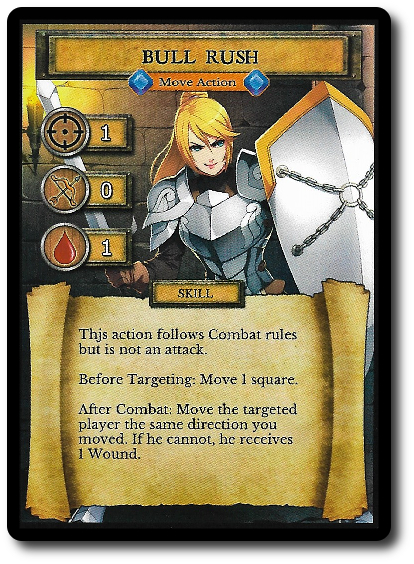
The Attack Action
Attack actions use Spells, Skills, Weapons, and other tactics. They are intended to cause Wounds to the player’s opponent’s character. Only one Attack action can be taken on the player’s turn. If they cannot take an Attack action or choose not to, the player can take a second Move action.
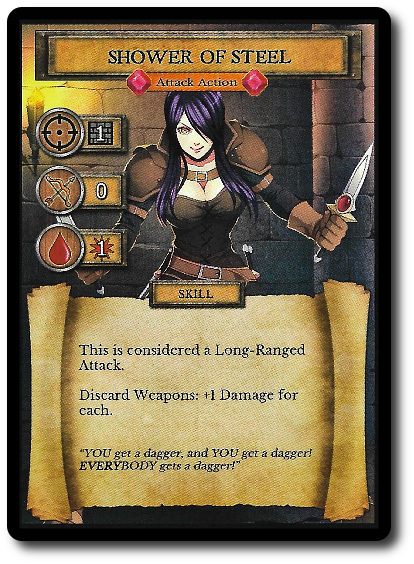
In addition to the general Move and Attack action, there are several other special actions the player can taken on their turn.
Double Action
This special action uses both the player’s Move and Attack action on their turn. Any effect that prevents Move or Attack actions also prevents a Double Action.
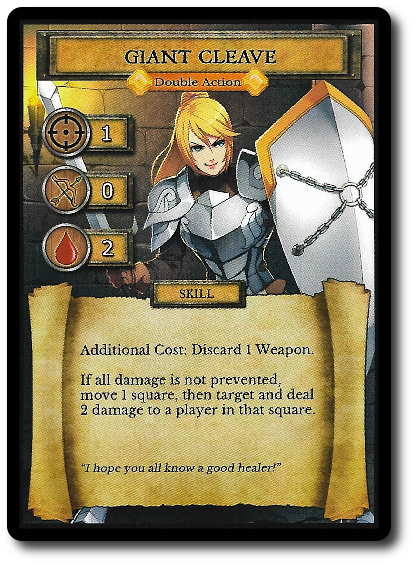
Quick Action
This special action can be taken as many times as the player has cards of this type. Quick actions do not count towards a player’s action limit, but can still be prevented.
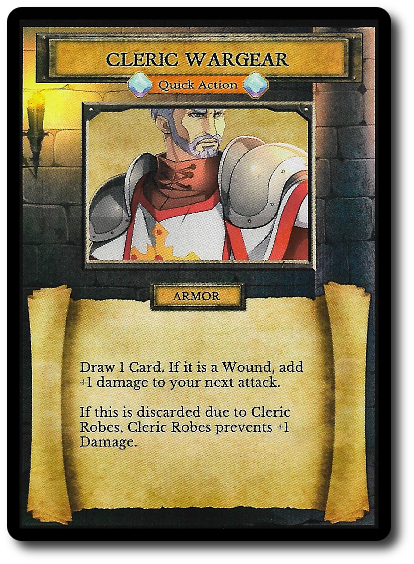
Variable Action
This special action gives the player a choice. While most actions spell out exactly what is to be done and the possible result, variable actions leave it up to the player to decide what should be done. For example. using the card as their Move action or as a Quick action. Only one option can be taken from those offered.

Reaction Action
This special action is only played out of turn and is played to thwart an opponent’s action. Reactions can only be used if specific conditions are met. Only one copy of a Reaction can be played at a time, meaning a player cannot have the same Reaction card in front of them more than once.

Deal With the Pain Action
This special action allows the player, once per turn, to discard two Wound cards from their hand to draw one card from their deck, adding it to their hand. This is considered a Quick action.
Wait Action
This special action is, ironically, a non-action. The player can declare they are “waiting” and is not required to play any cards. No card is necessary to use this action. The player is still free to play Reactions.
Phase Four: Cleanup
Any cards they played are now placed in the player’s discard pile unless they state they should remain. Cards that remain will be removed during the player’s next turn.
Phase Five: Discard and Redraw
The player’s turn is now over. The player now has a choice to make. They must do one of the following:
- Discard all cards left in their hand and draw cards up to their hand size limit
- Keep one card in their hand and discard all remaining cards, drawing cards up to their hand size limit
At anytime during the game when a player is required to reveal or draw a card from their draw deck and cannot because there are no cards to be had, they shuffle their discard pile to create a new deck.
Combat Clinic
Combat in Dungeon Brawl is all about the cards played and the position of the player’s Character pawn in relationship to the opponent’s Character pawn. When attacking (be it with a Weapon, Skill, or Spell), it always follows the same pattern.
- Target: The player selects the opponent’s Character pawn that is within range of the attack. Range is counted using the squares as a guide. If the target is within range, the next step is taken.
- Damage: The player declares how much damage is inflicted per the card used.
Now the player’s target has an opportunity to defend themselves. There is no order to this and what can and cannot be done is, again, based on the cards the player has available to them. Reaction cards can be played at this time, reducing damage inflicted. Armor tokens can also be used (provided by Armor cards), by discarding one Armor token to reduce the damage inflicted.
The results of the combat exchange are now calculated. Any damage not deflected is considered a “Wound”. For every Wound the target takes, they draw one card from the Wound draw deck.
If the player did not take their Move action or use a Double Action, they can now adjust the position of their Character pawn on the game board, putting themselves in a more tactical spot.
Artifacts, Treasure, and Wounds
Each player begins the game with an Artifact card, a powerful one-of-a-kind relic. They will enter the player’s hand from time to time when drawn. Like all the cards in the game, they can be played at certain times, per the description provided on the card.
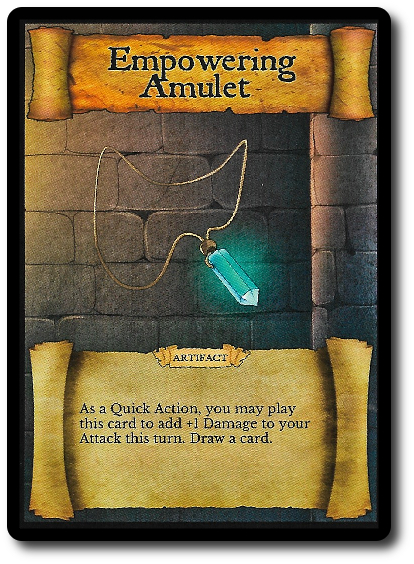
Treasure cards represent one small portion of the vast wealth the players are fighting for. Each Treasure card is equal to one point at the end of the game. However, Treasure is heavy and burdensome. When a player claims a Treasure card, it goes into their discard pile and eventually their draw deck where it will eventually be drawn into the player’s hand. Treasure is great to look at, but does nothing to help the player survive. Essentially, Treasure cards are “junk” until the end of the game.
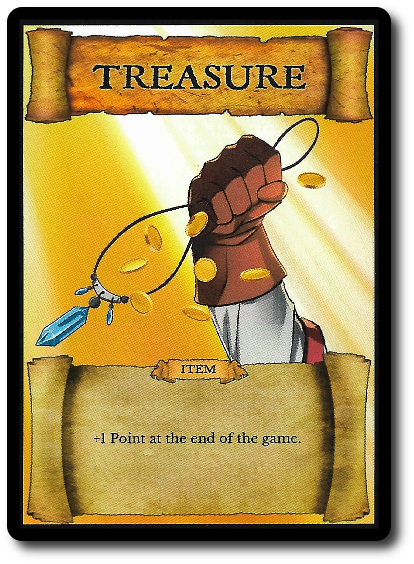
Wound cards represent the damage the player’s character inflicts on others and suffers. Wound cards, like Treasure cards, are added to the player’s discard pile and eventually added to the player’s draw deck where they will be drawn into the player’s hand. Wounds cannot be used for an action and are thus useless. Each Wound card is worth one negative point at the end of the game (essentially canceling the benefits of one Treasure card). The negatives of a Wound, however, can be mitigated. Players can take the “Deal With the Pain” to discard two to draw one new card and various Spells, Items, and Armor can be used to prevent and even heal Wounds (removing them from the player’s deck). This is referred to as “Removing”. Any card that is “Removed” is placed next to the Wound draw deck, face-up.
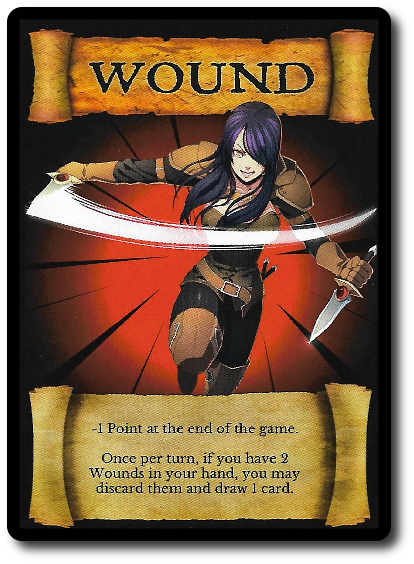
Speaking of the Wound deck, it’s a mixed bag at best. It contains both Wound and Treasure cards (per the game set up). When a player is forced to draw from the Wound deck (a specific number of cards is normally ordered), they draw from the top and reveal them one at a time. If a Wound card is drawn, the player places it in their discard pile. If a Treasure card is drawn, it’s given to the opponent who triggered the draw from the Wound deck. In this way, it’s possible for a player to not receive any Wound cards while drawing, but this would result in giving their opponent a lot of Treasure cards!
The Final Cut
There are two ways the game can end.
The Best Way
When the last card in the Wound draw deck is drawn, the current round finishes as normal and the next round is considered the final round. The game ends when the last player in the turn order sequence completes their turn in the final round. If the last player in a round is also the same player who draws the last Wound card, the round simply ends at the end of their turn. If a player must draw more cards than there are available in the Wound draw deck, they take the required number of Wound cards from the Wound the discard pile.
Players now count all their collected Treasure cards, where each card is equal to one point. Then they count the number of Wound cards, where each card reduces the total number provided by Treasure cards by minus one. They cancel each other out.
The player with the most points wins the game. If all players have less than zero points, the player with the closest to zero wins. Ties are broken by determining which player has the least number of Wounds.
The Worst Way
During a player’s Discard and Redraw phase (at the end of their turn), if they should draw a hand of cards that is nothing but Wounds, the character is considered “dead”. This immediately ends the game and all the player’s lose. Thematically speaking, the argument that the player’s were having over the treasure just got super serious and everyone snaps out of it. Guilt wracks the party over the unnecessary death of their fallen comrade and they leave the dungeon with all the Treasure which is then spent on a Temple Healer to resurrect their fallen companion.
Game Variant
If players want a longer game, they can add an additional five Wounds and five Treasure cards when they set up the game.
To learn more about Dungeon Brawl, visit the Kickstarter campaign.
Final Word
 The Child Geeks had a lot of fun, especially the older ones when creating their decks. According to one Child Geek, “I love it when you have just the right cards in the your hand and you get to smile evilly at the player across the table from you.” Yikes. Combat is fast and furious in Dungeon Brawl, which appealed to the many, but (if you pardon the pun) was also a double-edged sword. When attacking, the players felt great. When they got attacked and by multiple opponents, they sang a different tune. As one Child Geek put it, “It stinks when you don’t have the cards to defend yourself and you have to take wounds.” It certainly does, but as a result, all the players learned the hard way that ganging up and being too aggressive in a game that is all about fighting can be taken too far. When one player’s character died, they all lost. Many of the Child Geeks disliked this, but they all told me later (in secret) that they thought it was the best possible outcome. I have no idea why they wanted to tell me privately. Kids are like that. Dungeon Brawl was openly declared a success.
The Child Geeks had a lot of fun, especially the older ones when creating their decks. According to one Child Geek, “I love it when you have just the right cards in the your hand and you get to smile evilly at the player across the table from you.” Yikes. Combat is fast and furious in Dungeon Brawl, which appealed to the many, but (if you pardon the pun) was also a double-edged sword. When attacking, the players felt great. When they got attacked and by multiple opponents, they sang a different tune. As one Child Geek put it, “It stinks when you don’t have the cards to defend yourself and you have to take wounds.” It certainly does, but as a result, all the players learned the hard way that ganging up and being too aggressive in a game that is all about fighting can be taken too far. When one player’s character died, they all lost. Many of the Child Geeks disliked this, but they all told me later (in secret) that they thought it was the best possible outcome. I have no idea why they wanted to tell me privately. Kids are like that. Dungeon Brawl was openly declared a success.
 The Parent Geeks immediately understood that Dungeon Brawl was about holding back. While they didn’t necessarily have the words to describe it, they all felt that the game required a surprisingly high level of strategy, tactics, and most of all, memory. According to one Parent Geek, “You have to really watch each battle. If a player starts to take a lot of Wounds, you need to be careful not to attack them. On the other hand, if you see a player taking a lot of Treasure, you should smack them silly.” To a point. Treasure and Wounds go in the same hand and it can be difficult to keep track of who is rich and who is bleeding. Most of the times, it’s a mix of both. As one Parent Geek put it, “This is a fun and fast game. I really liked it. Never felt too heavy, but I always felt like I had to think.” All the Parent Geeks voted to approve Dungeon Brawl.
The Parent Geeks immediately understood that Dungeon Brawl was about holding back. While they didn’t necessarily have the words to describe it, they all felt that the game required a surprisingly high level of strategy, tactics, and most of all, memory. According to one Parent Geek, “You have to really watch each battle. If a player starts to take a lot of Wounds, you need to be careful not to attack them. On the other hand, if you see a player taking a lot of Treasure, you should smack them silly.” To a point. Treasure and Wounds go in the same hand and it can be difficult to keep track of who is rich and who is bleeding. Most of the times, it’s a mix of both. As one Parent Geek put it, “This is a fun and fast game. I really liked it. Never felt too heavy, but I always felt like I had to think.” All the Parent Geeks voted to approve Dungeon Brawl.
 The Gamer Geeks were totally into the game’s theme, but somewhat skeptical regarding the game’s approach to combat. According to one Gamer Geek, “Games that limit a player’s actions to cards are just fine. That’s what a deck-building game is all about, but when it comes to combat, nothing is more frustrating than not being able to strategically and tactically react simply because you don’t have the right cards.” This, however, turned out to not be a big concern since all players start the game with everything they need to survive. This pleased the Gamer Geeks, as did the differences in the classes. As one Gamer Geek put it, “I like how each class has its own unique approach to surviving. Throwing in the Artifact cards gives each game a certain special twist, where the humble Wizard can be a monumental bad ass because they have an artifact that makes them much more versatile.” The key word here is “versatile”, as in the ability to adapt. Each class was found to be useful and fun to play by the Gamer Geeks, and of course, they all had their favorites, including how to build their deck. When the last dagger was thrown and treasure collected, they all voted to approve Dungeon Brawl.
The Gamer Geeks were totally into the game’s theme, but somewhat skeptical regarding the game’s approach to combat. According to one Gamer Geek, “Games that limit a player’s actions to cards are just fine. That’s what a deck-building game is all about, but when it comes to combat, nothing is more frustrating than not being able to strategically and tactically react simply because you don’t have the right cards.” This, however, turned out to not be a big concern since all players start the game with everything they need to survive. This pleased the Gamer Geeks, as did the differences in the classes. As one Gamer Geek put it, “I like how each class has its own unique approach to surviving. Throwing in the Artifact cards gives each game a certain special twist, where the humble Wizard can be a monumental bad ass because they have an artifact that makes them much more versatile.” The key word here is “versatile”, as in the ability to adapt. Each class was found to be useful and fun to play by the Gamer Geeks, and of course, they all had their favorites, including how to build their deck. When the last dagger was thrown and treasure collected, they all voted to approve Dungeon Brawl.
 The most interesting aspect of this game, for me, was how the players had to hold back with their aggressive game play. You want to give your opponents Wounds, but only to a point. You want to collect Treasure, but only to a point. Players can quickly “junk” their hand with cards that causes them to be far less effective. I saw this as a neat mechanical way to thematically represent the gradual decline in the player’s character’s energy and will to fight. Greed, after all, is a powerful motivator but it has its limits.
The most interesting aspect of this game, for me, was how the players had to hold back with their aggressive game play. You want to give your opponents Wounds, but only to a point. You want to collect Treasure, but only to a point. Players can quickly “junk” their hand with cards that causes them to be far less effective. I saw this as a neat mechanical way to thematically represent the gradual decline in the player’s character’s energy and will to fight. Greed, after all, is a powerful motivator but it has its limits.
I also really enjoyed the different classes. Each had its ups and downs, but none had a defined strength that made them all-powerful. As a whole, the characters in the game make a very powerful adventuring party, with each providing a special skill set that contributes to the success of the group. Taken individually, each is effective but limited. Their strengths are also their weaknesses. For example, the Warrior is heavily armored, but not great at causing big damage. She’s a “war turtle”. As in, she can take a lot of hits and is best in combat over a long period of time. In contrast, the squishy Wizard can be damaged easily, but is also capable of causing a lot of damage over a large area. Any player familiar with the standard fantasy character classes will immediately recognize that the game designer did his homework.
I very much enjoyed Dungeon Brawl and have yet to play a game where I walk away from the table feeling cheated. Frustrated for certain, but never cheated. The frustration comes from not having “just the right card” when I needed it. Hindsight is a harsh teacher and I would spend time away from the gaming table lamenting my decision to discard a card that I should have kept or not using a certain card to move my character out of harms way. Lessons learned in previous games are useful in the next, but even your opponent’s change. The Cleric you battle last round that inflicted a lot of damage is suddenly very hard to hit due to different cards. There is no real constant in the game, as the players always have a set number and style of cards they can change. Great stuff.
Do play Dungeon Brawl when time allows. For the Fantasy game buffs, this is going to be a treat. Raw combat at its finest and surprisingly fast and strategic with tactical card plays and positioning on the dungeon floor. For those who like a good card game where you need to constantly evaluate, Dungeon Brawl will also please. The only folks I have met who didn’t like the game are those who haven’t played it yet.
This is a paid for review of the game’s final prototype. Although our time and focus was financially compensated, our words are our own. We’d need at least 10 million dollars before we started saying what other people wanted. Such is the statuesque and legendary integrity of Father Geek which cannot be bought except by those who own their own private islands and small countries.



